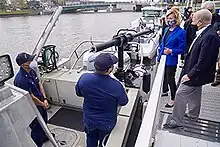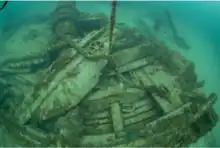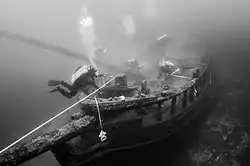Wisconsin Shipwreck Coast National Marine Sanctuary
The Wisconsin Shipwreck Coast National Marine Sanctuary is one of 15 United States National Marine Sanctuaries[2] administered by the National Oceanic and Atmospheric Administration (NOAA), an agency of the United States Department of Commerce; NOAA co-manages the sanctuary jointly with the State of Wisconsin. It is located in Lake Michigan along the coast of Wisconsin. It was created in 2021 to protect shipwrecks considered nationally important archaeological resources.[3]
| Wisconsin Shipwreck Coast National Marine Sanctuary | |
|---|---|
 A National Oceanic and Atmospheric Administration maritime archaeologist conducts a site survey of the wreck of the vessel Niagara in the Wisconsin Shipwreck Coast National Marine Sanctuary on June 8, 2022. | |
| Location | Lake Michigan, off Wisconsin, United States |
| Coordinates | 44°00′N 87°36′W and vicinity[1] |
| Area | 726 sq nmi (962 sq mi; 2,490 km2) |
| Established | 2021 |
| Governing body | NOAA Office of National Marine Sanctuaries |
| sanctuaries | |


Description
The Wisconsin Shipwreck Coast National Marine Sanctuary covers approximately 726 square nautical miles (962 sq mi; 2,490 km2)[3][4][5][6] in Lake Michigan off Wisconsin's Ozaukee, Sheboygan, Manitowoc, and Kewaunee counties.[4] It includes approximately 82 miles (132 km) of Wisconsin′s coast[4] and lies entirely within the state waters of Wisconsin,[4] extending approximately 7 to 16 miles (6.1 to 13.9 nmi; 11 to 26 km) from the coast.[4] Principal cities along the coast include Port Washington, Sheboygan, Manitowoc, and Two Rivers, Wisconsin.[4][6]
At the time of its designation in 2021, the sanctuary included 36 known shipwrecks[3][5][6][4] dating from the 1830s to the 1930s,[5] including Wisconsin's two oldest known shipwrecks in terms of vessel construction date,[4][6] the schooners Gallinipper, which was constructed in 1833 and sank in 1851, and Home, which was built in 1843 and sank in 1858.[7][8][9] The wrecks provide a cross-section of the types of ships that connected Wisconsin with other Great Lakes ports between the early 1800s and the 20th century.[6] Archival research indicated that the sanctuary could include another 59 or 60 such shipwrecks (sources provide both figures) that had yet to be discovered.[3][4][5][6] Twenty-one of the known shipwrecks were listed on the National Register of Historic Places.[4][5][6] Thanks to the cold, fresh water of Lake Michigan, several of the known shipwrecks were essentially intact and looked much like they did when they sank.[4][5][6]
NOAA and the State of Wisconsin jointly manage the sanctuary.[2][3][4][5][6]
History
Designation

In 2008, the Wisconsin Historical Society published a report titled "Wisconsin's Historic Shipwrecks: An Overview and Analysis of Locations for a State/Federal Partnership with the National Marine Sanctuary Program, 2008."[4] Drawing on this report, the State of Wisconsin on December 2, 2014, submitted a nomination asking NOAA to consider designating the area as a national marine sanctuary.[4][10] On February 5, 2015, NOAA added the area to its inventory of nominated areas eligible for designation as national marine sanctuaries.[4] On October 7, 2015, NOAA announced its intention to designate the area as a sanctuary,[3][4][10] initiating a 90-day public comment period during which NOAA held three public meetings on the designation in November 2015.[10] On January 9, 2017, NOAA published a notice of its intention to designate a 1,075-square-mile (2,780 km2) area[4] as the Wisconsin-Lake Michigan National Marine Sanctuary, continaing the sites of 37 known historic shipwrecks.[4][10] An 81-day public comment period and a series of four meetings in the Wisconsin towns of Algoma, Manitowoc, Sheboygan, and Port Washington during the week of March 13, 2017, followed which led NOAA to alter the sanctuary's boundaries, reducing its area to 926 square miles (2,400 km2), including 36 known historic shipwrecks, and to change its name to Wisconsin Shipwreck Coast National Marine Sanctuary.[4][10] NOAA published an environmental impact statement and final management plan in June 2020,[3][10] designated the area as a sanctuary on June 22, 2021,[6] and published the designation in the Federal Register on June 23, 2021.[4][10] The designation was to take effect formally in the autumn of 2021[5] following 45 days of continuous session of the United States Congress after publication of the designation in the Federal Register.[4][6] After the 45-day review period in Congress and by the Governor of Wisconsin was complete, the designation became effective on August 16, 2021.[10] The designation was finalized and celebrated in ceremony attended by U.S. Senator Tammy Baldwin, Governor of Wisconsin Tony Evers, NOAA Administrator Dr. Rick Spinrad, and local officials at the Wisconsin Maritime Museum in Manitowoc on October 9, 2021.[11][12] The Wisconsin Shipwreck Coast National Marine Sanctuary was the first national marine sanctuary created in the United States since the designation of Mallows Bay, Maryland, as a sanctuary in 2019.[6]
Upon designating the area as a sanctuary, NOAA announced that it would stay a prohibition on grappling into or anchoring on shipwreck sites in the sanctuary until October 1, 2023.[4] The delay in the imposition of this regulation was intended to give NOAA time to install mooring buoys that would make anchoring or grappling unnecessary, establish policies allowing access to shipwrecks where mooring buoys would not be installed, and explore the possibility of allowing some diving activities it originally intended to prohibit, such as allowing divers to attach mooring lines directly to some shipwrecks.[4] The designation is the second of its kind for the Great Lakes and the first for Lake Michigan.[13]
2021

The NOAA Office of Coast Survey began a survey of the sanctuary's waters in June 2021 to collect data in support of nautical charting of the waters and archaeological studies of cultural resources in the sanctuary, but mechanical problems forced a delay.[12] The survey resumed in early October 2021.[12] By the time it concluded on October 22, the NOAA team had surveyed 70 square miles (53 sq nmi; 180 km2) of the lakebed near Manitowoc and Sheboygan, including four known shipwrecks.[12][14]
During 2021, the sanctuary installed three real-time wind-and-wave buoys also capable of providing real-time water temperatures at different depths in sanctuary waters off Port Washington, Sheboygan, and Two Rivers.[14][15] The buoys were intended to enhance boating safety and fishing in the sanctuary.[15] The sanctuary also teamed with its research partners to use autonomous underwater vehicles to explore sanctuary waters off Two Rivers as part of a NOAA-led search for maritime heritage resources in Lake Michigan and Lake Ontario between July 28 and August 20, 2021.[14]
2022

During 2022, the NOAA Office of Coast Survey awarded a contract for a high-resolution, sonar-based mapping of most of the sanctuary′s lakebed, following up on the pilot mapping project carried out in 2021.[15] The sanctuary also participated in the creation of a podcast and digital short promoting tourism in the communities along Wisconsin′s mid-Lake Michigan coast[15] and co-sponsored a hands-on learning experience about marine technology and archaeology for 20 Wisconsin teachers from the Manitowoc-Two Rivers area, Milwaukee, and Green Bay.[15] By 2022, a study was underway to explore the creation of a NOAA facility along the Wisconsin coast to support the sanctuary.[15]
In June 2022, a NOAA Office of National Marine Sanctuaries team conducted maritime archaeological assessments at 11 shipwreck sites and sonar mapping at 13 sites and collected 6k video and virtual reality footage to collect data in support of resource monitoring, mooring buoy, and education and outreach programs in the sanctuary.[14]
In August 2022, the sanctuary began accepting applications to serve on its 15-seat advisory council, made up of members of the local community, with applications due by October 1, 2022. The creation of an advisory council is a standard practice for U.S. national marine sanctuaries.[17]
2023
In September 2023, maritime historicans announced the July 2023 discovery of the wreck of the 140-foot (43 m) American schooner Trinidad, which sank on May 11, 1881, in 270 feet (82 m) of water off the coast of Wisconsin near Algoma. The wreck was in "pristine" condition, but lies just outside the national marine sanctuary, prompting its discoverers to make plans to work with the Wisconsin Historical Society to request its addition to the National Register of Historic Places in order to increase its visibility as an historically important shipwreck and to ensure its protection.[18]
NOAA′s plans to install mooring buoys in the sanctuary during the summer of 2023 went unfulfilled because NOAA's partner organizations were unable to provide ship time for the buoy installation effort. On September 29, 2023, the NOAA Office of National Marine Sanctuaries extended the stay on the prohibition of grappling into or anchoring on shipwreck sites in the sanctuary from October 1, 2023, to October 1, 2024, to allow an additional year to address public comments on the effect of the prohibition on commercial shipping and engage in outreach to educate the public on the location of shipwrecks and non-destructive means for mooring to them, as well as to delay the prohibition until after the installation of mooring buoys, which NOAA rescheduled for the summer of 2024.[19]
Gallery


 Bow section of the schooner Mahoning on June 11, 2022.
Bow section of the schooner Mahoning on June 11, 2022.

References
- Approximation based on coordinates at "Wisconsin Shipwreck Coast National Marine Sanctuary Designation; Final Regulations". NOAA via Federal Register. June 23, 2021. Retrieved 29 June 2021.
- National Marine Sanctuaries press release: Wisconsin Shipwreck Coast National Marine Sanctuary Accessed 29 June 2021
- National Marine Sanctuaries: Wisconsin Shipwreck Coast National Marine Sanctuary Accessed 29 June 2021
- "Wisconsin Shipwreck Coast National Marine Sanctuary Designation; Final Regulations". NOAA via Federal Register. June 23, 2021. Retrieved 29 June 2021.
- National Marine Sanctuaries media document: Wisconsin Shipwreck Coast National Marine Sanctuary Accessed 29 June 2021
- NOAA News "NOAA designates new national marine sanctuary in Wisconsin’s Lake Michigan," June 22, 2021 Accessed 29 June 2021
- Haun, Eric, "Proposed Sanctuaries Aim to Protect Historic Shipwrecks," Marine Technology News January 6, 2017 Accessed 1 July 2021
- Wisconsin Shipwrecks: GALLINIPPER (1832) Accessed 1 July 2021
- Wisconsin Shipwrecks: HOME (1843) Accessed 1 July 2021
- "History of the Wisconsin Shipwreck Coast NMS Designation," noaa.gov Accessed September 5, 2023
- Krall, Annie, et al., "NOAA, state leaders celebrate final designation of Shipwreck Coast National Marine Sanctuary," WBAY.com, October 9, 2021 Accessed 23 October 2021
- Anonymous, "Navigation Response Team attends National Marine Sanctuary designation," Coast Survey Biweekly Newsletter (NOAA), October 27, 2021 Accessed September 5, 2023
- "Dozens of Shipwreck Discoveries Anticipated in New Marine Sanctuary". Scientific American. 11 November 2021. Retrieved 18 November 2021.
- National Marine Sanctuaries — Wisconsin: Science Accessed September 5, 2021
- Green, Russ, and Mike Friis, "The Wisconsin Shipwreck Coast National Marine Sanctuary is an investment in our past and future," Wisconsin Great Lakes Chronicle, 2022, p. 10.
- NOAA Ocean Exploration: "Maritime Heritage in America’s Inland Seas: A Multi-Tiered Autonomous Vehicle-Based Survey of Two Proposed Great Lakes National Marine Sanctuaries;" "Maritime Heritage in America’s Inland Seas: Expedition Overview," noaa.gov Accessed September 5, 2023
- Denman, Katie, "NOAA Seeks Applicants for Wisconsin Shipwreck Coast National Marine Sanctuary Advisory Council," NOAA National Marine Sanctuaries, August 2022 Accessed September 5, 2023
- Clough, Christopher; Encinas, Amaris (September 5, 2023). "'A time capsule': 156-year-old sunken ship found in pristine condition in Lake Michigan". USA Today. Retrieved September 8, 2023.
- "Designation of Wisconsin Shipwreck Coast National Marine Sanctuary; Delay of Effectiveness". Federal Register. National Archives and Records Administration. 29 September 2023. Retrieved 11 October 2023.
External links
- Official website
- NOAA video "Designation of Wisconsin Shipwreck Coast National Marine Sanctuary" on YouTube
- NOAA video "Wisconsin Shipwreck Coast National Marine Sanctuary B-roll" on YouTube
- NBC 26 video "Wisconsin Shipwreck Coast becomes the 15th National Marine Sanctuary" on YouTube
- NOAA video "Wisconsin Shipwreck Coast National Marine Sanctuary Educators at Sea" on YouTube